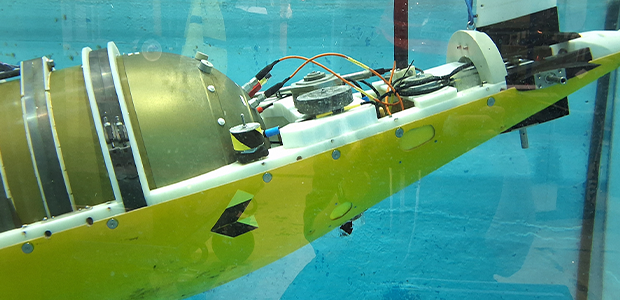
Boaty McBoatface sails to new horizons with quantum pioneers at the helm
Hold on to your life jackets! Aquark Technologies, a member of the NATO DIANA Accelerator Programme, has announced the details of its latest trial. In an unexpected collaboration, the autonomous submersible vehicle National Oceanography Centre (NOC) Autosub Long Range (ALR), affectionately known as Boaty McBoatface, made a splash in the world of quantum technology, being the vessel of choice for Aquark to send its AQuest system into the depths.
Southampton-based startup Aquark Technologies, which specialises in reducing the size, weight, power consumption, and cost of quantum-enabling technologies, successfully and continuously trapped cold atoms in dynamic conditions underwater for the first time. The company trialled its ultra-cold atom source in NOC’s massive indoor test tank.
The result? A boatload of data was collected about the system’s behaviour and robustness in these challenging conditions, including performance metrics at different temperatures and pressures. The insights gathered will support improvements to the reliability of Aquark’s cold atom systems, which could be used in applications like advanced navigation, medical diagnostics, and environmental monitoring.
What makes the trial remarkable is that laser cooling atoms is only possible when a system is completely isolated from most external disturbances. This means forming ultra-cold atom clouds poses a big engineering challenge, even on dry land. Aquark Technologies and NOC overcame these challenges with ease.
This extreme sensitivity makes cold atoms the perfect choice for quantum sensing applications since noise can be selectively reintroduced, allowing for an unprecedented level of precision for measurement, surpassing the limitations of classical sensors.
Andrei Dragomir, Co-Founder & CEO, Aquark Technologies, said: “Seeing our platform work alongside NOC's Autosub – known as Boaty McBoatface – was a real win for both science and fun. It was fantastic to demonstrate the compatibility of our platform with the ALR’s pressure vessel, and the resounding success of this trial has opened new doors for research enabled by quantum technologies.
“In the future, we may be able to measure the density of minerals under the sea floor using gravity measurements or perform high-sensitivity magnetic field measurements, giving scientists new ways of seeing things that were previously hidden. We may even uncover some hidden treasures!”
Villius Atkočius, Quantum Systems Engineer, Aquark Technologies, said: "This is the first time a cold atom trap has been tested underwater, and we have achieved it with our unique Super Molasses Trap (SMT). The underwater world is less understood than space, so the potential for this is huge. Gravity sensing platforms like Aquark’s SMT are more reliable than traditional magnetic field sensing when working for long periods underwater or near the polar regions. With this trial with the NOC, we have shown the platform works, and we expect real-life applications to follow quickly after.”
Dr. Alex Phillips, Head of Marine Autonomous and Robotics Systems at NOC said, “Quantum sensing has the potential to make a substantial contribution to underwater navigation and seabed imaging. These initial tests illustrate that quantum technologies are now close to making the transition out of the laboratory and into underwater vehicles like Autosub Long Range.”
For more startup news, check out the other articles on the website, and subscribe to the magazine for free. Listen to The Cereal Entrepreneur podcast for more interviews with entrepreneurs and big-hitters in the startup ecosystem.

